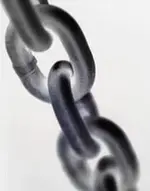Modern chain the links are butt welded.

Note the weld on the two links. The weld is on the left hand side.
Hand forged chain can be remarkably uniform and well made. The easiest way to tell is to look for the forge weld on the link. Rather than trying to go into great detail, check out the following site, which shows and tells how hand made chain is done.
Rural Blacksmith: Link by link, chain by chain.
In the fourth picture down, the pile of chain on the stump, the lowest link on the left hand side shows what the forge weld looks like. And if you look close at the one above it, you can see the line from the weld. As far as telling age, location would probably be the best clue. I found a chain in Nevada that looked like a cow pie. The chain had apparently been dropped of the back of a wagon, something where it ran into a pile, then the links had rusted together. The iron grain could be seen in the rust. Knowing that wagon trains had camped there, I figured that chain to date between the 1850's and the turn of the century at the latest.
From what I can find the earliest chain was BC and was for jewelry. The first steel chain was supposedly drive chain for bicycles. Here is the history of one company that still manufactures chain.
Laclede Chain Manufacturing Company has origins dating back to 1854, making us the oldest domestic chain manufacturer. We started business as a blacksmith shop in St. Louis, Missouri, manufacturing wagon hardware for the wagon trains heading west. Most significantly we produced breast chain, trace chain and anti-spreader chains to support wagons under load. This chain was made, as it is today, from drawn rod or wire, the difference being that it was all formed with a blacksmith's hammer and individually welded and joined over a hearth and bellows. By the 1890's, the company grew into an industrial concern selling chain and hardware on a national basis. In the early 1920's we purchased the new electric forming and welding machines from Europe. These machines were later reverse engineered and the company built numerous machines itself. By 1976 the company operated two chain manufacturing plants, one in St. Louis, and the other in Maryville, Missouri in the northwest corner of the state. In 1983 and 1984 the company began to look at the cost of maintaining a two-plant operations and examining ways to produce higher quality products with the best cost structure. This led to a 30,000 square foot addition at the more modern Maryville facility.
Without dates, there was supposed to be a time when chain was cast. I don't know how that would work. But one method was link and pin, and that was cast. I think they were talking about drive chain in that case though.




